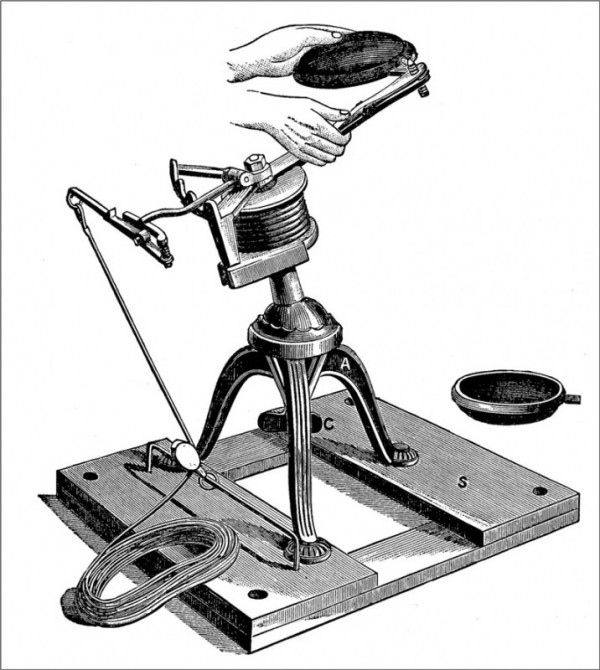
“Mud saucer” sherds, George Ligowsky, Cincinnati, Ohio, ca. 1880. Earthenware. (Photo, Michael Murphy.) These are among the few mendable clay pigeon sherds found at Bull’s Island, New Jersey.

Mud saucer, George Ligowsky, Cincinnati, Ohio, ca. 1880. Earthenware. D. 4 1/2". (Courtesy, Amateur Trapshooting Association Hall of Fame and Museum, Vandalia, Ohio.) Note the molded clay throwing tongue or tab.

George Ligowsky of Cincinnati, Ohio. (Courtesy, Amateur Trapshooting Association Hall of Fame and Museum, Vandalia, Ohio.)

Ligowsky’s “portable 15 lb. sender,” patented 1882. (Courtesy, Cleveland Public Library.)
In January 2002 archaeological monitoring conducted by Hunter Research, Inc., in conjunction with mechanical excavations for a new park office at Bull’s Island Recreation Area, Bull’s Island State Park, Delaware Township, Hunterdon County, New Jersey, uncovered from a small refuse pit located in the center of the island an unusual clay artifact worthy of note.[1] The refuse pit feature was observed immediately beneath the topsoil and cut down into the subsoil. An indeterminate portion of the pit was exposed at this time, with the remainder of the feature extending beyond the limits of excavation. The excavated portion of the pit contained artifacts ranging in date from 1850 to 1900. Included in the assemblage were more than 150 pieces of saucer-shaped unglazed red earthenware clay pigeons. Only seventeen of the sherds were mendable, suggesting the pit was used to dispose of the fragments of broken targets (fig. 1). Broken targets are hardly unusual, as any trap shooter can attest: almost every new case of clay pigeons contains three or four broken ones.
Measuring 4 1/2 inches in diameter, the upper exterior portion of the target exhibits molded concentric rings or banding (fig. 2). Near the base is a small flat tab or tongue used to grip the target when throwing by hand. The targets were slip-cast in a cast iron mold, then inverted with the excess slurry leaving telltale drip marks around the interior center. The dried targets were then baked in a kiln. The lip exhibits evidence of trimming with a sharp instrument, probably a knife. The top is marked with impressed lettering: “GEO LIGOWSKY / PAT / SEP 7 / 1880 / CINCINNATI O.”
George Ligowsky of Cincinnati, Ohio, has been credited with giving modern-day trapshooting its start with his oven-baked red earthenware clay targets or “mud saucers,” which he patented on September 7, 1880 (fig. 3). The domed saucer reportedly was derived from watching boys skipping clam shells across the water. Ligowsky’s targets would ring like a bell when they were hit by lead shot. Due to variability in firing temperatures, some targets were so durable they were nearly impossible to break.[2] An earlier version of Ligowsky’s target was fitted with a heavy paper tongue, which was glued to the base. Complaints that the tongues would get stuck in the arm of the throwing device and could not be used in the rain caused Ligowsky to redesign the targets to include a clay tongue.
Ligowsky would receive an additional six patents for his targets between 1881 and 1885.[3] The original red clay targets sold for a price of $20 per thousand or 2¢ per target, an inexpensive alternative to glass balls (introduced in 1866 by Charles Portlock from England) or live passenger pigeons, which in 1868 reportedly sold for 15¢ apiece.[4] Clay targets were viewed as an improvement over glass ball targets as more closely emulating the flight of a bird. In 1892 W. W. Greener stated the ball targets “have been superseded by the Ligowsky Clay Pigeon Trap and Pigeons. The Pigeons . . . are very thin concave below and convex above, and are skimmed from the trap with a most irregular flight.”[5] In 1882 Ligowsky patented a fifteen-pound portable device for throwing, or sending, the clay targets (fig. 4).[6] The portable sender had at the end of the swing arm a clamp that was used to hold the target’s tongue.
In 1880 Ligowsky introduced his clay targets at the New York State Shoot at Coney Island.[7] To promote his new product he hired two of the nation’s top target (glass ball and live bird) shooters, Captain Adam H. Bogardus and Doctor W. F. “Doc” Carver to tour the country shooting his clay targets in a one-on-one competition.[8] In 1885 he was instrumental in setting up the first national trapshooting tournament in New Orleans. By 1892 millions of Ligowsky’s targets were being used by Americans. Eventually red clay was replaced by crushed limestone and pitch, which was easier to break. As W. W. Greener put it, “for officers in the army and sportsmen in the summer months, they offer a never-ending source of amusement.”[9]
William B. Liebeknecht, Principal Investigator, Hunter Research, Inc.;
wbl@hunterresearch.com
William B. Liebeknecht, “Archaeological Monitoring, New Park Office, Bull’s Island Recreation Area Bull’s Island State Park, Delaware Township, Hunterdon County, New Jersey” (letter report from Hunter Research, Inc. to Studio Tagland Architecture, P.C., June 20, 2002).
Kenneth P. Czech, “Pottery Pigeons: George Ligowsky and Modern Trapshooting,” Timeline 11, no. 2 (March–April 1994): 22–27.
Ibid.
“George Ligowsky Enshrined on August 19, 1969,” National Trapshooting Hall of Fame Honored Inductees, www.traphof.org/inductees/ligowsky.htm (accessed March 23, 2008). See also Dick Baldwin, “The Road to Yesterday: A. H. Bogardus Trap and Field 2000,” www.traphof.org/roadtoyesterday/december2000.htm (accessed March 23, 2008).
Michael Yardley, “A History of Clay Pigeon Shooting,” Internet Gun Club News and Articles (April 2003), www.internetgunclub.com/articles/showarticle.php?id=39 (accessed March 23, 2008).
Czech, “Pottery Pigeons,” p. 26.
See “History of Trapshooting,” www.youthtrapshooter.com/trapshooting_history.html (accessed March 23, 2008).
Czech, “Pottery Pigeons,” p. 25.
Yardley, “History of Clay Pigeon Shooting.”
